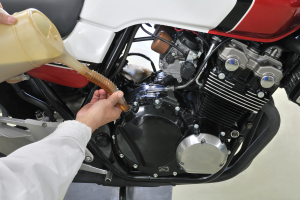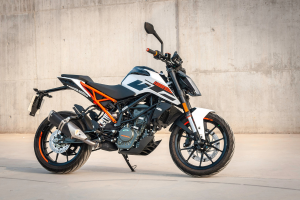Learn About Air Cooled Motorcycles
Before learning about air cooled motorcycle oil, learn about air-cooled motorcycles.
Whether you’re a new motorcycle owner or a seasoned pro, the more you learn about your bike’s engine the better equipped you will be to take care of it.
Regardless of how many miles you’ve put on your motorcycle, differences in engine design offer an opportunity for the owner to fine-tune their bike’s performance.
This all begins with maintenance, like regular air cooled motorcycle oil changes using a high-quality synthetic motor oil!
In this article, we will talk about the different kinds of engine cooling as well as which oil is best for air-cooled motorcycle oil or liquid-cooled engines.

What Is an Air Cooled Engine?
Air-cooling is pretty much as simple as it sounds.
This method of cooling the engine relies on air moving over the engine as it moves down the road.
This is often encouraged by fins affixed to the exterior of the engine, which increase the surface area and encourage better cooling potential.
This tried-and-true method of engine cooling has been used for decades thanks to its simplicity and the fact that it does not require a lot of extra weight.
If you’ve ever seen a motorcycle with fins on the engine, this is why!
In some models of motorcycles or motorized scooters, forced air cooling is employed.
This method involves an engine-powered fan that distributes air over the internal engine body as well as over the exterior fins.

What Is a Liquid-Cooled Engine?
The other kind of engine cooling method requires a water-based solution, which contains an alcohol-based coolant.
This ingredient prevents the liquid from freezing or rusting as it travels from place to place on an engine.
This type of engine cooling is considered more complex than air cooling, as it requires the addition of a radiator and more pipes.
While liquid-cooled engines do have more of a capacity to break and “go wrong” just by merit of having more parts to maintain, they do offer some benefits to offset this.
One such benefit is a reduction in engine vibration, which means better efficiency as well as less mechanical noise.
Another benefit is the liquid cooling system helps keep the engine at a regular temperature regardless of the temperature outside.
This increases your engine’s adaptability and stabilizes the performance in a wider range of possible weather scenarios.

So, Which Motor Oil Is Best?
While air-cooling and liquid cooling are both ultimately effective, one is not necessarily better than the other.
Some people like the louder operating volume of an air-cooled motorcycle, and don’t want to mess around with a radiator.
Others prefer to do their riding in all kinds of climates and prefer the stability that comes with a liquid-cooled engine.
Regardless of your personal preference, knowing how your engine cools is important to its overall maintenance.
So, which motor oil is best for an air-cooled engine? How about a liquid-cooled engine?
By and large, the air-cooled motorcycle oil that beats the competition is AMSOIL’s Synthetic V-Twin Motorcycle air cooled motorcycle oil.

This synthetic air cooled motorcycle oil has additives that make for long-term viscosity and resistance to shear.
AMSOIL’s Synthetic V-Twin Motorcycle air cooled motorcycle oil is capable of lubricating at extremely high temperatures, and also resists foaming, which can lock in more heat.
This keeps things running smoothly and as they should, for longer.
Best oil for air-cooled motorcycle engines
When it comes to air-cooled motorcycle engines, choosing the right oil is crucial for optimal performance, protection, and longevity.
Air-cooled engines tend to operate at higher temperatures compared to liquid-cooled engines, making it essential to select an oil that can withstand these elevated temperatures and provide excellent lubrication.
Let’s delve into the details of the best oil options available for air-cooled motorcycle engines.
- Full Synthetic Oil:
Full synthetic oils are highly recommended for air-cooled motorcycle engines due to their superior thermal stability and excellent lubricating properties. These oils are specially formulated with advanced additives and a synthetic base stock, offering exceptional resistance to heat and oxidation. They provide enhanced protection against wear, deposits, and engine sludge, ensuring optimal engine performance even under extreme operating conditions.
- High Viscosity Oil:
Air-cooled engines can benefit from oils with higher viscosity ratings, such as 20W-50 or 10W-40. These oils have thicker consistency, which helps maintain proper lubrication and oil pressure, especially in hot climates or during extended periods of high engine temperatures. The higher viscosity ensures sufficient oil flow and prevents excessive thinning at elevated temperatures, reducing the risk of engine wear and maintaining consistent protection.
- Motorcycle-Specific Oil:
Using oil specifically designed for motorcycles is highly recommended. Motorcycle oils are formulated to meet the unique demands of motorcycle engines, including air-cooled models. They typically contain specialized additives that cater to the requirements of motorcycle engines, offering superior protection against heat, friction, and engine stress. Look for oils labeled as “motorcycle” or “motorcycle-specific” to ensure compatibility and optimal performance.
- Brands with a Track Record:
Opting for oils from reputable brands with a proven track record in the motorcycle industry is a wise choice. Brands such as Mobil 1, Castrol, Motul, and Amsoil have established themselves as leaders in producing high-quality motorcycle oils. These brands invest in research and development to formulate oils that meet the specific needs of air-cooled motorcycle engines, providing peace of mind and confidence in their performance.
Remember to consult your motorcycle’s owner’s manual for the manufacturer’s oil recommendations.
While synthetic oils are generally preferred, some older or vintage motorcycles may have specific requirements for conventional or mineral-based oils.
Always follow the manufacturer’s guidelines to ensure the best compatibility and performance for your air-cooled motorcycle engine.
In summary, selecting the best oil for air cooled motorcycle engines involves choosing a full synthetic oil or a high viscosity oil designed for motorcycles.
Opting for reputable brands with a proven track record in the motorcycle industry ensures quality and performance.
By using the right oil, you can provide optimal lubrication, heat resistance, and protection for your air-cooled motorcycle engine, allowing you to enjoy a smooth and reliable ride for years to come.
Mobil 1 motorcycle oil 20w50
Mobil 1 Motorcycle Oil 20W-50 is a high-quality oil specifically formulated for motorcycles, including those with air-cooled engines.
This oil is designed to provide excellent lubrication, protection, and performance in a wide range of riding conditions.
Here are some key features and benefits of Mobil 1 Motor Oil 20W-50:
- Enhanced Thermal Stability: This oil is engineered to withstand the high operating temperatures experienced by air-cooled motorcycle engines. It offers exceptional thermal stability, ensuring optimal performance even in demanding riding conditions.
- Advanced Additive Technology: Mobil 1 Motorcycle Oil 20W-50 incorporates advanced additive technology that helps reduce engine wear, combat deposits and sludge buildup, and maintain engine cleanliness. This promotes long engine life and consistent performance.
- Excellent Shear Stability: The oil maintains its viscosity and shear stability over extended periods of use, providing reliable protection and consistent lubrication, even during high-speed and high-stress riding situations.
- Enhanced Wet Clutch Performance: Mobil 1 Motorcycle Oil 20W-50 is formulated to be compatible with motorcycles equipped with wet clutches. It offers excellent clutch engagement and disengagement characteristics, ensuring smooth and reliable operation of the clutch system.
- Quick Cold-Start Protection: This oil provides quick oil flow at startup, even in colder temperatures, ensuring rapid lubrication and minimizing engine wear during critical moments when the engine is not yet up to operating temperature.
- Compatibility: Mobil 1 Motorcycle Oil 20W-50 is suitable for a wide range of motorcycles, including cruisers, touring bikes, sport bikes, and off-road motorcycles. It meets or exceeds the requirements of major motorcycle manufacturers, making it a reliable choice for various motorcycle brands and models.
When using Mobil 1 Motorcycle Oil 20W-50, it is important to follow the manufacturer’s recommendations regarding oil change intervals and viscosity requirements.
Regular oil changes, along with proper maintenance and care, will help keep your motorcycle’s air-cooled engine running smoothly and performing at its best.
Please note that it is always recommended to consult your motorcycle’s owner’s manual for the specific oil requirements and recommendations provided by the manufacturer.
This ensures compatibility and optimal performance for your motorcycle engine.
Best 20/50 motorcycle oil
When it comes to choosing the best 20W-50 motorcycle oil, there are several high-quality options available on the market.
Here are some of the top choices:
- Mobil 1 V-Twin Synthetic Motorcycle Oil 20W-50:
Mobil 1 V-Twin Synthetic Motorcycle Oil is specifically designed for high-performance V-Twin engines, making it an excellent choice for cruiser and touring motorcycles. It offers exceptional thermal stability, excellent wear protection, and superior engine cleanliness. This oil provides enhanced performance, smooth shifting, and reliable protection even in extreme operating conditions.
- Castrol Power 1 V-Twin 4T 20W-50 Synthetic Motorcycle Oil:
Castrol Power 1 V-Twin Synthetic Motorcycle Oil is formulated to meet the demands of V-Twin engines. It offers excellent protection against heat and wear, ensuring reliable performance and extended engine life. This oil provides superior film strength, improved acceleration, and smoother gear shifts, making it an ideal choice for V-Twin motorcycles.
- Motul 7100 Synthetic Ester 20W-50 Motorcycle Oil:
Motul 7100 Synthetic Ester Motorcycle Oil is a high-performance oil suitable for a wide range of motorcycles. It is formulated with synthetic ester technology, providing excellent lubrication and protection. This oil offers outstanding resistance to high temperatures, reduces friction and wear, and ensures optimal engine performance and longevity.
- Valvoline 4-Stroke Motorcycle Oil 20W-50:
Valvoline 4-Stroke Motorcycle Oil is a conventional oil designed for 4-stroke motorcycles. It offers reliable protection, improved engine cleanliness, and enhanced performance. This oil provides good shear stability, easy cold starts, and efficient lubrication, making it a cost-effective option for motorcycles requiring 20W-50 viscosity.
- Amsoil Synthetic Metric Motorcycle Oil 20W-50:
Amsoil Synthetic Metric Motorcycle Oil is formulated for metric motorcycles, including those with air-cooled engines. It offers superior protection against heat, wear, and deposits. This oil provides smooth shifting, excellent clutch performance, and reliable engine protection in various riding conditions.
When selecting the best 20W-50 motorcycle oil, it is essential to consider your motorcycle’s specific requirements, including the manufacturer’s recommendations for viscosity and oil specifications.
Always consult your motorcycle’s owner’s manual to ensure the oil you choose is compatible and meets the necessary standards for optimal performance and engine protection.
Remember, regular oil changes and following the recommended maintenance schedule will help keep your motorcycle’s engine running smoothly and prolong its lifespan.
Air cooled motorcycle engines
Air-cooled motorcycle engines are a type of engine design commonly found in motorcycles, particularly older or classic models.
Unlike liquid-cooled engines that use a radiator and coolant to regulate temperature, air-cooled engines rely on natural airflow to dissipate heat and maintain operating temperatures.
The primary characteristic of an air-cooled engine is the presence of cooling fins on the engine cylinders and heads.
These fins increase the surface area of the engine, allowing heat to be efficiently dispersed into the surrounding air.
As the motorcycle moves forward, air passes over the cooling fins, carrying away the heat generated during combustion.
One advantage of air-cooled engines is their simplicity and reduced complexity compared to liquid-cooled engines.
They have fewer components, such as radiators and coolant hoses, which can be prone to leaks or failures.
Air-cooled engines also tend to be lighter and more compact, contributing to the overall weight savings of the motorcycle.
However, air-cooled engines have some considerations regarding their operation and maintenance.
Due to their reliance on airflow for cooling, these engines can be more susceptible to overheating, especially in hot weather or during prolonged periods of idling or slow-speed riding.
It is essential to monitor engine temperatures and avoid prolonged idling to prevent overheating and potential engine damage.
Regular maintenance is crucial for air-cooled engines to ensure their optimal performance and longevity.
Here are some key maintenance aspects for air-cooled motorcycle engines:
Cooling System: Inspect the cooling fins regularly and ensure they are free from dirt, debris, or blockages that can impede airflow.
Clean them gently using a soft brush or compressed air if necessary.
Oil Changes: Regularly change the engine oil according to the manufacturer’s recommendations.
Clean oil helps lubricate and cool the engine components, reducing friction and heat buildup.
Spark Plugs: Check and replace spark plugs as needed. Properly functioning spark plugs contribute to efficient combustion and prevent overheating.
Air Filter: Clean or replace the air filter regularly to ensure proper airflow to the engine. A clogged air filter restricts air intake and can lead to overheating.
Ignition Timing: Periodically check and adjust the ignition timing to maintain optimal engine performance.
Correct ignition timing helps prevent overheating and ensures efficient combustion.
Riding Practices: Avoid excessive idling or prolonged periods of slow-speed riding, as these conditions can limit airflow and lead to overheating.
Instead, maintain a steady speed or take short breaks to allow the engine to cool down if necessary.
By following these maintenance practices and staying attentive to the engine’s temperature, air-cooled motorcycle engines can provide reliable performance and longevity.
Remember to consult your motorcycle’s owner’s manual for specific maintenance guidelines provided by the manufacturer, as different models may have unique requirements.
FAQs
Q. What is the best engine oil for air-cooled motorcycles?
A. The best engine oil for air-cooled motorcycles is typically a high-quality, synthetic oil that is formulated specifically for motorcycles with air-cooled engines. These oils are designed to provide superior heat resistance and excellent lubrication, which is crucial for maintaining optimal performance and protecting the engine components. It is recommended to choose an oil that meets the viscosity and performance requirements specified by the motorcycle manufacturer.
Q. Do air-cooled engines need special oil?
A. While air-cooled engines do not necessarily require special oil, it is highly recommended to use oil that is suitable for air-cooled applications. Air-cooled engines tend to operate at higher temperatures compared to liquid-cooled engines, so using oil with the right viscosity and additives can help manage heat and provide adequate lubrication. Motorcycle-specific oils, particularly those formulated for air-cooled engines, often offer enhanced thermal stability and protection against high-temperature wear.
Q. Can I use 2-cycle oil for air-cooled engines?
A. No, it is not recommended to use 2-cycle oil in air-cooled engines. 2-cycle oil is specifically formulated for use in engines that require a fuel-oil mixture, such as small two-stroke engines found in certain power equipment like chainsaws or leaf blowers. Air-cooled motorcycle engines typically use separate oil and fuel systems, requiring dedicated engine oil that meets the manufacturer's specifications.
Q. Do air-cooled engines use oil?
A. Yes, air-cooled engines, including those in motorcycles, require oil for lubrication and cooling purposes. Oil plays a critical role in reducing friction between moving engine components, preventing wear, and carrying away heat from the engine. It is important to regularly check the oil level and perform oil changes at the recommended intervals to ensure proper lubrication and cooling of the air-cooled engine.
Air Cooled Motorcycle Oil
Chances are you’ll be better off with a synthetic motor oil capable of increasing the life of your engine as well as the number of miles between air-cooled motorcycle oil changes.
Knowing this tidbit about your engine can keep it running well into the foreseeable future, so long as you take the right steps to maintain it.
Want to learn more about different kinds of motor oils?
To browse current AMSOIL motorcycle oils, click here!



